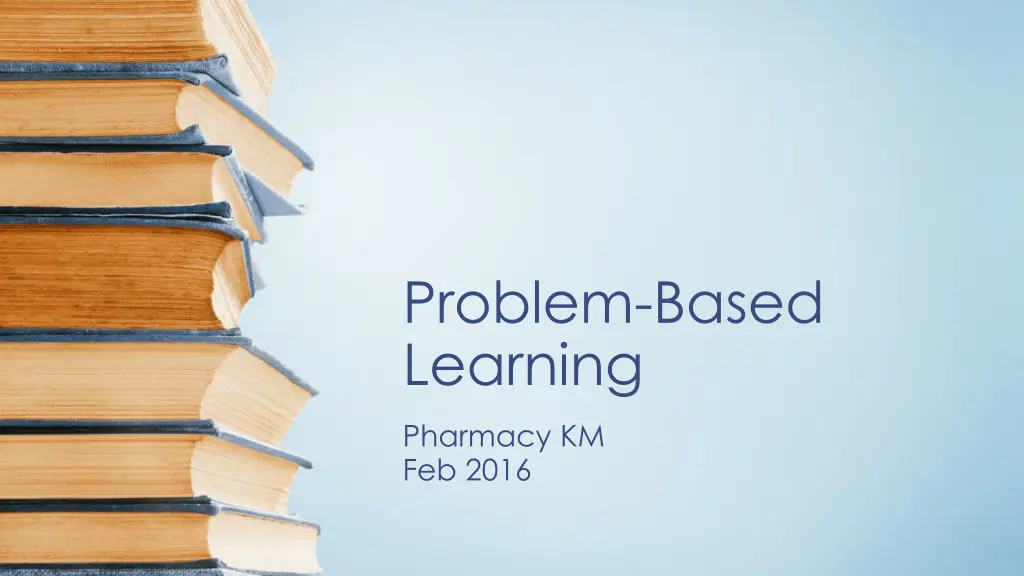
Problem-Based Learning in Pharmacy Education
Discover the concept of Problem-Based Learning (PBL) in pharmacy education, its advantages over traditional curricula, and the roles of both teachers/tutors and students in the PBL process. Learn how PBL enhances integration of knowledge, communication skills, teamwork, and self-directed learning in pharmacy students.
Download Presentation

Please find below an Image/Link to download the presentation.
The content on the website is provided AS IS for your information and personal use only. It may not be sold, licensed, or shared on other websites without obtaining consent from the author. If you encounter any issues during the download, it is possible that the publisher has removed the file from their server.
You are allowed to download the files provided on this website for personal or commercial use, subject to the condition that they are used lawfully. All files are the property of their respective owners.
The content on the website is provided AS IS for your information and personal use only. It may not be sold, licensed, or shared on other websites without obtaining consent from the author.
E N D
Presentation Transcript
Problem-Based Learning Pharmacy KM Feb 2016
What is PBL? Teaching method where the use of problems is the starting point for learning It is through these problems that student acquires knowledge and skills required
Advantages over traditional curricula Improve integration of basic and applications Improve communication Team working skill Self-directed learning Information retrieval skill More enjoyable and motivational format
Role of the Teacher/Tutor in PBL? Prior to class: Creating cases, scenarios or problems Identify your target group Formulate the objective to be achieved by the student Choose a format: picture, graph, description of phenomena Prepare the manual for the tutors (1 student group/tutor) Student evaluation method
Role of the Teacher/Tutor in PBL? In the class Putting the problem in context and help prioritizing issues Encourage all group members to participate Assist chairman with group dynamics and keeping to time Check scribe keeps an accurate record Stimulate the use of audio-visuals Prevent side-tracking Ensure group achieves appropriate learning objectives; Check understanding Assess performance Feed back to students
Role of the student in PBL? Leader/Chairperson: Lead the group through the process Encourage all members to participate in the discussion Keep group dynamics Time keeping Ensure group keeps to task in hand Ensure scribe can keep up and make an accurate record Scribe/secretary: Record points agreed upon by group members Help group order their thoughts Participate in discussion Record resources to be used by group
Role of the student in PBL? Members Follow the steps of the process of PBL as it has been agreed upon Participate effectively in the discussion Listen to and respect contributions of others Ask open questions to stimulate the discussion Research all the learning objectives Share information within the group
Steps of the process of PBL Step1 Clarify the setting Do you understand words, terms and notions? Do you agree on what they mean? Step3 Analyse/investigate the case Brainstorming Step4 Re-structure the problem Group related points Throw irrelevant points away Try to get a systematic overview of the problem Step2 Define the problem What are the problems? What are the sub-problems? Select the problems/sub-problems you will continue to work on!
Steps of the process of PBL Step5 Formulate learning goals What do you need to learn before you can solve the case problems? Write down the learning goals Step6 Individual learning Each student study all the learning goals Step7 Report back to the group What have you learnt? Use it for solving the case problem!
Factors determine the successful functioning of PBL Prior knowledge: the amount of prior knowledge and activation of the prior knowledge in the discussion Quality of the problem: well constructed and matching to the student s knowledge Tutor Behaviour Student self-determination for learning Team work Group Dynamics: everyone is participating efficiently and effectively Ground Rules
Thank you for your attention
